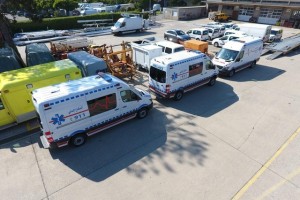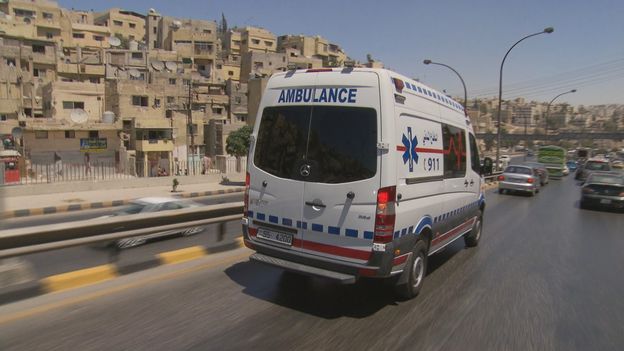
Civil Defence Ambulances: Swiss made vehicles will improve safety
Thanks to an important partnership between Switzerland and the Jordan Civil Defence, the European state-of-the-art equipment for rescue and emergency will be in the hands of Jordanian paramedics.
Jordan is receiving from Switzerland a total amount of 140 new ambulances for the Civil Defence, equipped with the most advanced medical devices, stretchers and defibrillators.
The project, which involves the Swiss Secretariat of Economy, is not only a good undertaking in development, but it will also acquire humanitarian achievement. Take into consideration the serious situation of Syrian refugees, who are growing day by day, for example.
Civil Defence Ambulances: about the project
Dr. Olivier Hagon, Medical Coordinator in the Swiss Humanitarian Unit, says to Emergency Live: “This project started 3 years ago. Jordan is a fantastic country that I know for a long time. I was involved in the SAR training of the Jordanian team in 2009, and we made a first assessment of the needs in all the Country. As you could imagine, the needs of the north and the south of Jordan are completely different. For example, in Amman, you can be hospitalized in about 8/10 minutes, but near the Iraqi borders, transportation needs nearly 2 hours. Close to Aqaba, in the south, there are different needs. It’s very important to take in consideration differences, especially in the rural areas”.
This is why the project, that in the end will furnish 140 new ambulances to the Jordan Civil Defence, has been not developed as a standard ambulances furniture:
“Jordan needs 4×2 ambulances, 4×4 ambulances and also special vehicles for refugee camp. Swiss manufacturer can realize specific products: for example, vehicles which can cross narrow street are a must-to-have in a refugee camp, and equipments have to facilitate paramedics facing stiff stairs and confined spaces. It’s a challenge to pass through!”.
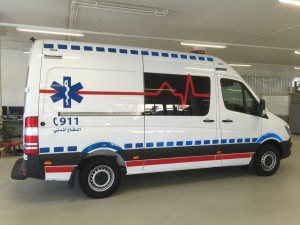 But Jordanian Civil Defence is a really innovative agency. They want the best for their skilled paramedics and professionals who are the most prepared of the Middle-East.
But Jordanian Civil Defence is a really innovative agency. They want the best for their skilled paramedics and professionals who are the most prepared of the Middle-East.
“We train Jordanian instructors who will train trainers. This model can duplicate the training speed on the ground. And this model will also improve the quality of the support to provide to the Jordan Civil Defence. We can give more confidence with security, handling and managements to the end-users. And we can also provide a quality incident case management model for future evaluation and a correct de-briefing”.
This activity is not so difficult in Jordan, thanks to the skills that paramedics acquire in their training school.
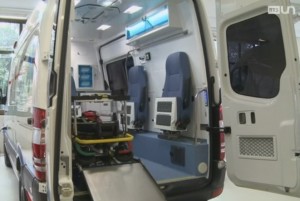 “In our activity, we don’t realize the usual training. Paramedics in Jordan are well educated in the good institute for Advanced Paramedics. We only train them in using equipment, explaining how easy-to-use new medical devices are, preventing injuries with more confidence and control. We ensure also a correct management of devices on special vehicles dedicated to refugee camps, where we include caterpillar chairs and – of course – such kind of equipment that will reduce low-back pain”.
“In our activity, we don’t realize the usual training. Paramedics in Jordan are well educated in the good institute for Advanced Paramedics. We only train them in using equipment, explaining how easy-to-use new medical devices are, preventing injuries with more confidence and control. We ensure also a correct management of devices on special vehicles dedicated to refugee camps, where we include caterpillar chairs and – of course – such kind of equipment that will reduce low-back pain”.
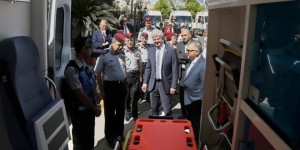 The Jordan Civil Defence selects – with the consultation of the Swiss partner – the innovative training systems and discharges the virtual training systems. There’s a big question:
The Jordan Civil Defence selects – with the consultation of the Swiss partner – the innovative training systems and discharges the virtual training systems. There’s a big question:
“We didn’t make use of online training. Indeed, the most important thing is handling, to be sure that every future trainer learns the how-to basis. The goal is to assure that paramedics will have the right knowledge about devices, and will assume the right position, the right side and so on… It’s better that trainer touches and understands the right use of instruments, in order to transmit the feelings to learners”.
But training skilled paramedics in this field is not for everyone. This is why Hagon finds the right person among other paramedics.
“The person in charge of this formation is not an anaesthetist, she is a paramedic and she has been a teacher in paramedic school in Geneva. She was involved also in the SAR training here in Jordan for a bit. The reason why we chose her is that Jordanian Paramedics don’t need special education as a paramedic. They need specific education on manoeuvring new devices.
Our second trainer is a medic, and the third trainer is a paramedic, too. We have two female trainers, because it’s really important the gender balance in Jordan, following the Jordan Civil Defence organization. We want to ensure a quick activity within the staff, and the percentage of female are quite important because they are more or less 40%” in the JCD”.
With this project, the importance of the Jordan Civil Defence Corps in the Middle-East will increase, setting up a good example of development. There are also some aspects to evaluate for what concerns the European forces:
“Even if I am doctor, I know the world of pre-hospital care quite well. The point is that paramedics work in a stand-alone situation quite often. When we plan this kind of project we have to understand what kind of paramedic we have to face. The situation is really different, compared with European paramedics. Usually in the Middle-East paramedics have low resources, and they don’t have a medical car in assistance. For example, the French SMUR structure doesn’t exist in Jordan. HEMS system is not possible here, either (Jordan is working on a specific HEMS structure, at the moment)”.
“You have to consider also that in this beautiful region is difficult reaching desert villages. So, European can take from Jordan some knowledge about how to work with limited resources and in difficult – really difficult – conditions. Bad weather is the most visible one, but also face dehydration or shock cases during Ramadan are hard cases to face”.
This is why the project of the Jordan Civil Defence will be a developing project that could set up a new way for all the Middle East countries. Other emergent Countries daily have to face many difficulties in this field – transport, unsuitable equipments, distant locations hard to reach, less trainings and so on – and often, people die as a result. We hope this project could become a good example to follow, in order to improve first aid scenarios all around the world, and how to use and work with limited resources at best.



